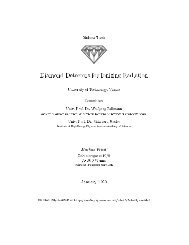Create successful ePaper yourself
Turn your PDF publications into a flip-book with our unique Google optimized e-Paper software.
Figure 3.9: The muon momentum resolution using the tracker only, the muon systemonly or both (“full system”) [16].become less important so that the muon chambers’ accuracy is limited by the positionresolution. For such tracks, the tracker’s p T resolution degrades through the limitedbending power of the small radius, and the resolution of the combined measurementsis much better than the individual resolutions. Figure 3.9 illustrates this behavior.3.2.9 Trigger and Data AcquisitionThe high-level organization of the CMS data acquisition path is shown in Fig. 3.10.Since the entire detector has about 55 million readout channels and collisions occurat a rate of 40 MHz in nominal LHC operation, it is clearly impossible to store alldata for later analysis. Even though the amount of data can be reduced to about1 MB per event using zero suppression, the available storage bandwidth is still only onthe order of 100 events per second. In order to resolve this problem, CMS employs atwo-level approach. While digitized data is held in local front-end systems (FES) onthe subdetectors for up to 3.2 µs (128 bunch crossings), the Level-1 Trigger subsystemhas to decide whether an event is potentially interesting for physics analysis on thebasis of coarse-grained information from the muon and calorimetry subsystems. Sincemost of this time is spent in signal transitions, the processing time for this decisionis limited to about 1 µs and makes an implementation using custom hardware andFPGAs necessary. The implementation of the Level-1 Trigger will be described inmore detail in Ch. 4. By design, the Level-1 Trigger should produce a maximumoutput rate of 100 kHz. Once the Level-1 Trigger decides to accept an event, the30












